FRIDAY
NOVEMBER 30 - 2012
LOCAL
NEWS
Magpie
in garden
After about 7 months
without seeing a Magpie in my garden, one now seems to
have taken up residence. I first saw it a few days ago
when it was trying to get some fat that I had rubbed
into the bark of the cherry tree. This was hard work
and it had little success. Now, it has discovered the
bird table on which I provide a liberal supply of seed
and chopped peanuts. It is a nice smart bird, but
appears very nervous and aware of me when I move
around behind the window. Most other birds take no
notice of my moving. However, I managed to get this
photo through the window without disturbing it.
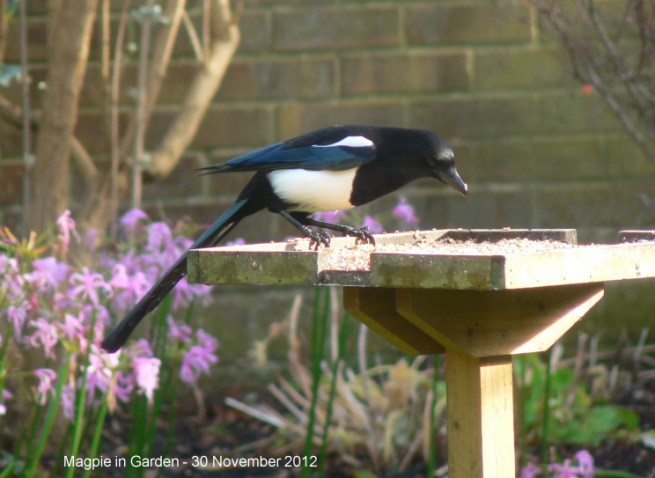
In view of its
scarcity in my garden I was surprised to find that
Magpie stands at number 10 on the all Britain list of
garden birds for this quarter of the year and is even
higher at number 6 on lists for the southern areas.
About half of participants in the BTO Garden BirdWatch
scheme report Magpies in the garden, with peaks in
winter and the nesting season. There is a low point in
September when many birds forage on farmland.
November
flower list
I completed my
personal list of flowering plants in the month of
November today with a Three-cornered Garlic in New
Road Westbourne. This takes the final total to 72
species. See the full list at . . . Winter
flowering plants
Ralph Hollins has
found lots more in the Havant area, probably over 100
in total. See his web summary . . . http://ralph-hollins.net/Summary.htm
Ferns in Westbourne
Maidenhair Spleenwort
is still growing very well on the flint wall in New
Road Westbourne along with Common Polypody on the high
brick wall at the far end of the lane. Both plants
have been there for many years.

Nuthatch
on Isle of Wight
Responding to
yesterday's entry about the Richard Grogan talk about
the Island wildlife, Ralph Hollins provided the
following extra information:
"Until recently
Nuthatches did not occur on the Isle of Wight but
there was one in the St Helens area in March 2009 and
there has been one in the Binstead area (just west of
Ryde) since Jan 2011. I rely on Derek Hale's website
for most of my news from the Island and I have just
checked his personal sightings which shows that he
does see one through the year now." See . . .
http://iowbirds.awardspace.com/IOW2012mlist.htm
Brook
Meadow frosty
Maurice Lillie
captured this beautiful image of Brook Meadow on a
frosty morning, looking north towards the railway
line.
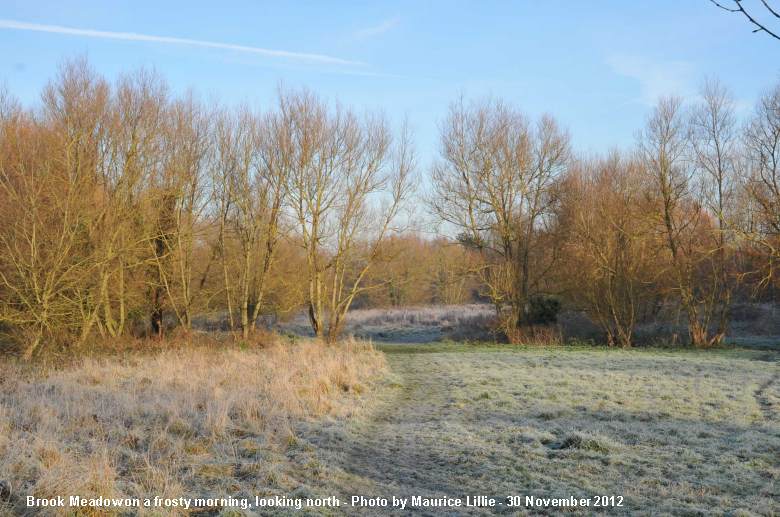
Red-breasted
Merganser
Derek Mills got this
excellent image of a male Red-breasted Merganser
struggling with a fish in Thorney Deeps. Help with the
type of fish would be most welcome.
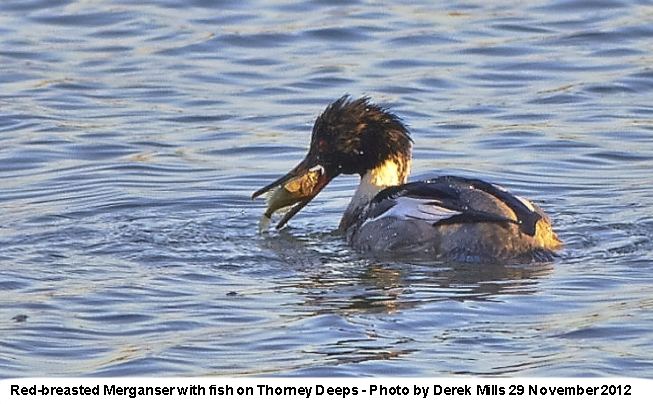
and
in Findhorn Bay
Meanwhile, Richard
Somerscocks also had some splendid Red-breasted
Mergansers in the Findhorn bay in Northern Scotland.
Richard said there were 13 this morning, most of which
were females. There were 5 others just offshore
although these were mainly males. He sees the ones in
the bay catching fish quite regularly.
Here
is a female Red-breasted Merganser with a small
flounder .
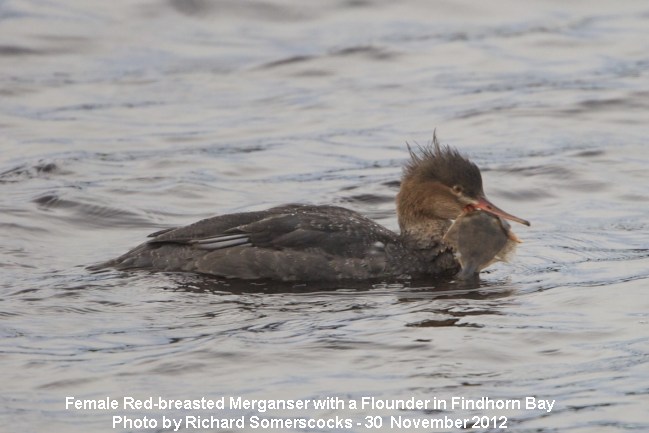
Richard
also gets good views of the males offshore displaying.
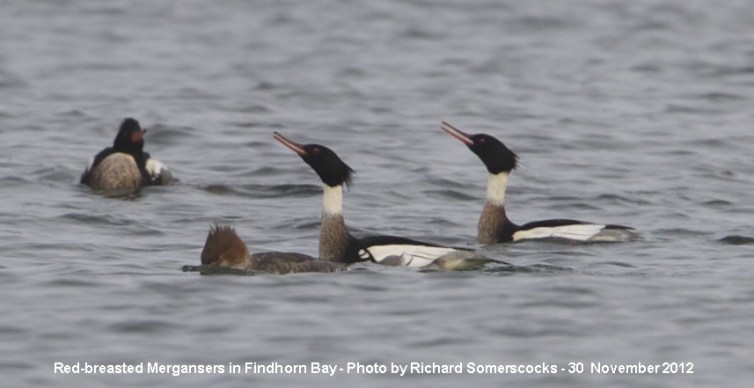
THURSDAY
NOVEMBER 29 - 2012
GARDEN
BIRDS
I had a Starling in
the garden today.
They are now very
rare visitors to the garden, but they used to be very
common. This is clearly shown by the following chart
which plots the mean weekly count since 1998.
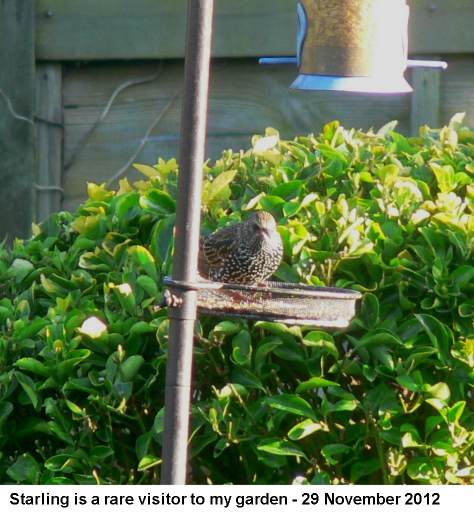

I also had a
Greenfinch feeding on the sunflower hearts.
This is another bird that used to be very common, in
fact my number one garden bird for many years, but is
now only an occasional visitor. Their numbers were
badly affected by the disease trichomonosis.
Woodpigeon is a
bird which has gone the other way and become far more
frequent in the garden than it used to be. Several are
now daily visitors to the garden, including this
juvenile Woodpigeon which prefers feeding on
the bird table to the ground. The juvenile differs
from the adult by having dark eyes and no white
collar. It differs from the similar Stock Dove by its
white wing flash and longer tail which extends well
beyond the wing tips at rest.

NORE
BARN
Ivy
hedge
The Ivy hedge near
where the coastal path meets the end of Warblington
Road still has a good number of open flowers
attracting insects.
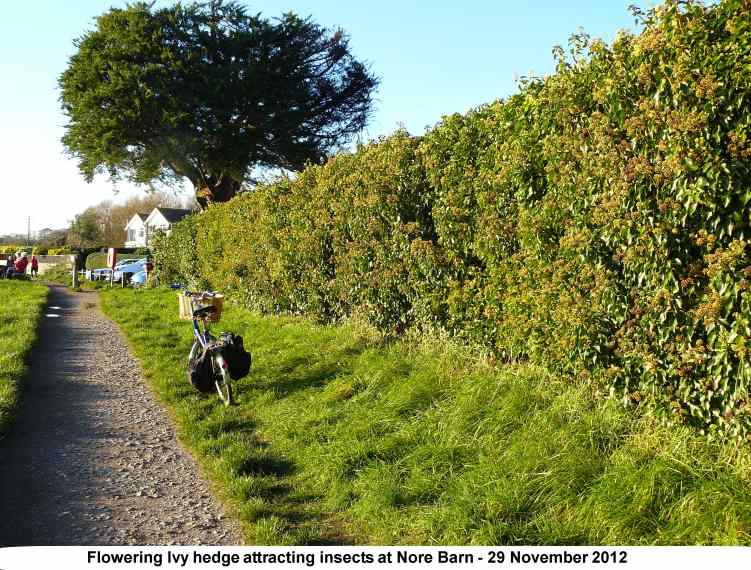
They seemed to be
mainly bluebottle type flies, though I did see one or
two Drone Flies and a Common Wasp. The Drone Flies are
very easy to photograph as they stay for some time on
each flower head whereas the Wasps are constantly
restless. There was also a single Garden Spider on its
web.
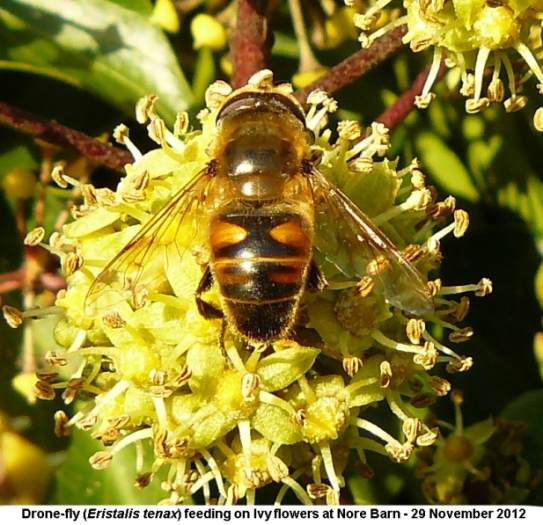
The
stream
14:30-15:00 - About 3
hours after high water. Spotted Redshank and
Black-tailed Godwit were feeding together in the
stream. A flock of 54 Black-tailed Godwits were on the
mudflats in Nore Barn Creek, but I did not have my
scope with me to check them for colour-rings.
PETER
POND
While passing by Peter
Pond this morning I spotted a smart Pied Wagtail
looking for scraps of food on the grass verge near
the seat.
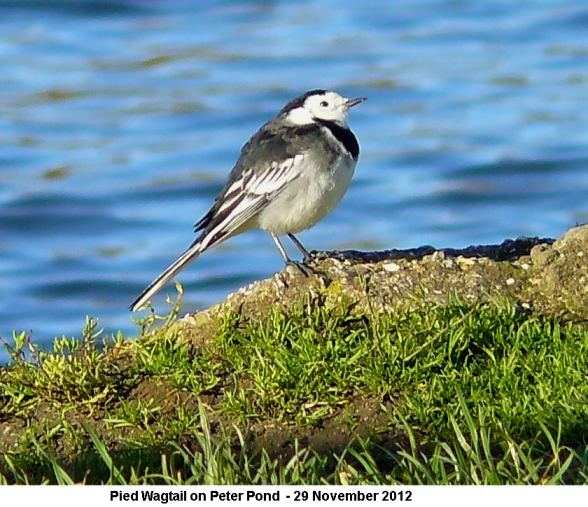
ISLE
OF WIGHT WILDLIFE
Last night I attended
the Hampshire Wildlife Trust talk by Richard Grogan
(the Trust's chief conservation officer on the Isle of
Wight). Like the previous talk by Chris Cockburn this
one was had a bumper audience on what was a chilly
night. The talk was excellent with Richard displaying
his deep knowledge (and love) of the island's
wildlife. Here are a few things I jotted down of
interest.
Richard said an
astonishing 6,000 Chalkhill Blue butterflies
were recorded on Arreton Down.
Four pairs of
Nightjar and two pairs of Ravens nested on the
new heathland area in Bouldner Forest.
Water Voles are
doing well on the island as there are no Mink. Unlike
on the mainland there has only been a small decline
their population over the past 50 years.
The absence of Deer
and Grey Squirrel means woodland growth is much
better than on the mainland.
Other absentees on the
island included Tawny Owl and Nuthatch.
Richard related the
story of how Field Cow-wheat used to be a
serious arable weed as the seeds made the flour
distasteful and people were employed to pull it up.
This plant is far more common on the Isle of Wight
than on the mainland. In fact, the Hants Flora
describes it as 'extinct', though I know some is well
established on Skew Road on the hill above
Portchester. Ralph Hollins checks them every year and
has a story that they were originally 'introduced'
several years ago from the Isle of Wight by someone
referred to as 'the Portchester Postman'.
Common Cow-wheat
is unlikely to be confused with Field Cow-wheat as
it has small deep yellow and white flowers in contrast
to the bright pink flower spikes of Field Cow-wheat. I
recall coming across some Common Cow-wheat in flower
during a walk around Northwood Cemetery in Cowes on
July 2 this year. It is fairly common on the Isle of
Wight and in the New Forest, but Ralph Hollins is not
aware of any in the Havant area.
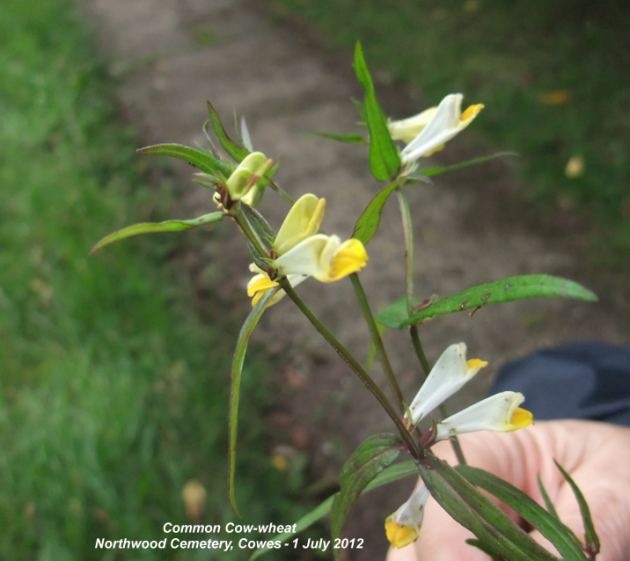
A
BAD YEAR FOR NESTING BIRDS
BTO have just
published the preliminary finding for the nesting
"success" of 25 species in 2012. The results clearly
show what a bad year it has been for nesting birds
with most birds performing worse than average.
However, many of the species have the potential to
bounce back rapidly following a poor breeding season
provided conditions improve. However, the extreme
conditions in 2012 were due to a shift in the jet
stream and it is difficult to predict how its position
may be influenced by future climatic warming and the
melting of the Arctic icecaps. If wet summers become
more frequent, then we may witness long-term changes
in the numbers of some bird species. See . . .
http://www.bto.org/volunteer-surveys/nrs/results/2012-preliminary-nrs-results
PEREGRINE
PREY
Tom
Bickerton provides more details about what Peregrines
prey on.
"It's difficult to
give a definitive answer. The best response would be
seasonal species. If we take our birds, they have been
taking advantage of the influx of European feral/wood
pigeons along the back of Portsdown Hill towards
Butser Hill, during mid-October to mid- November. You
are now seeing them back within the Harbour, as to
what they prefer, well, there's nothing within the
harbour which a female doesn't have on her menu, it's
more of a question of whether she can be bothered.
As to what species are
taken, well both male and female usually take the
easier option; both are not averse to bushwhacking a
passing wader. As regard my own records, mainly from
Cornwall, Hampshire, Sussex, Kent and Europe, these
are species I've recorded as prey items, either seen
caught or witnessed eating: Feral/Wood Pigeon, Grey
Plover, Oystercatcher, Sandwich Tern, Black Headed
Gull, Common Gull, Shelduck, Wigeon, Green Woodpecker,
Magpie, Starling, Jackdaw, Crag Martin, House Martin,
Black-tailed Godwit, Turnstone and Lapwing.
The following are
species I've seen hunted but the outcome was either a
failure or I just wasn't in a position to see the end
result: Curlew, Ringed Plover, Teal, Herring Gull,
Dunlin, Redshank, and Turtle Dove, Red Billed Cough,
House/Spanish Sparrow, Carrion Crow and
Rook.
The following are
species' remains found, which I can safely attribute
to Peregrine. Golden Plover, Dunlin, and Avocet. So,
it's quite a selection of prey items, undoubtedly
there's more smaller passerines taken and probably
larger species too."
WEDNESDAY
NOVEMBER 28 - 2012
HOLLYBANK
WOODS
It was a fine morning,
with a winter chill in the air, for a walk through
this beautiful woodland. The paths were extremely
muddy after the rain, but easily negotiable in
wellies. I walked the circular path through the
western section and then walked round the eastern
section, but did not go onto Longcopse Hill.
Conservation
work
I had not been to the
woods for a couple of months and was surprised to see
how much work had been achieved by the conservation
group, with large areas of the woodland opened up with
tree clearance and coppicing. I also noticed several
dead wood hurdles at key entrance points, which were
designed to control horse riding in those areas. There
was a work session in progress this morning in the
area to the west of the central path with Sweet
Chestnut trees being coppiced and harvested for posts.
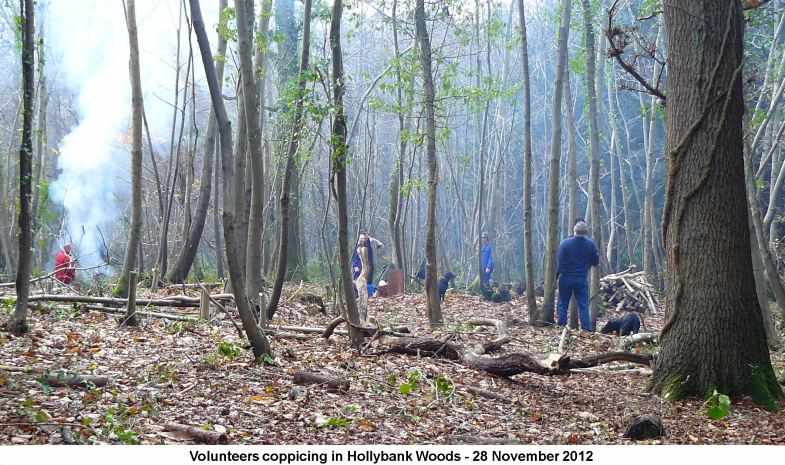
Wildlife
observations
I was struck by the
almost complete absence of Holly berries. There was
very little in the way of bird activity, though I did
see two separate Buzzards both flying low through the
woodland. The only flowering plant I noticed was
Wavy Bitter-cress with its wavy stems and 6
stamens on the flowers.

I had a walk along my
favourite mosses path at the far eastern side of the
woods near the conifer plantation. The Bank
Haircap was looking especially fine. I think the
pale spikes are new capsules forming.
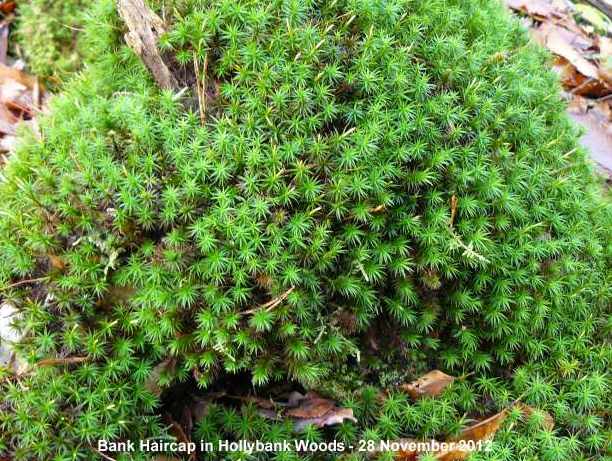
I was not looking for
fungi, but I did notice what looked like a small
Common Earthball nestling among the fallen
leaves.
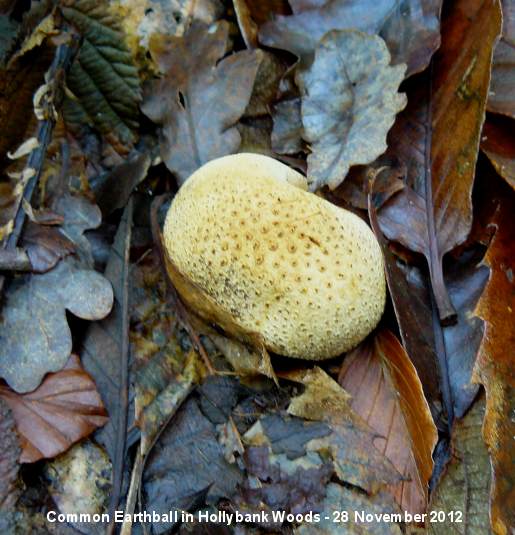
NORE
BARN
14:00 - About 3 hours
after high water. The Spotted Redshank was
present in the stream being watched by a photographer
with a long lens who was standing far closer than he
needed to get good photos. The Spotshank appeared to
be unconcerned, though the Greenshank, which was
approaching from the point, was I think deterred by
the photographer's presence.
OTHER
NEWS
Malcolm Phillips got
the following rather fine photo of a Nuthatch
from the window of his Emsworth flat. Nice one.

Charlie Annalls captured this nice image of an adult
Great Black-backed Gull and what is probably
one of this year's youngsters near the Ferryboat Inn
Hayling Island on Nov 26. The adult was intent on his
lunch, which looks like a fish head, and unwilling to
share. Charlie wondered whether this could have been
the same bird that I have been seeing on Slipper
Millpond. I think this is unlikely as the two sites
are several miles apart and there would be a number of
Great Black-backed Gulls in the local area.

TUESDAY
NOVEMBER 27 - 2012
EMSWORTH
NEWS
Nore
Barn
12:00 - I popped along
to Nore Barn about 2 hours after high water. Tide
still well in and the stream was full of water and I
was not expecting to see the Spotted Redshank or any
other birds in the stream. However, the Spotted
Redshank was present along with a Common Redshank,
both waiting patiently on the saltmarshes to the west
of the stream for the tide to fall. But I did not
stay.
Slipper
Millpond
An adult Great
Black-backed Gull was on the centre raft of Slipper
Millpond along with 4 Cormorants. This is most likely
one of the paiur that nested here this summer. They
appear to have taken up residency, though without
threatening any of the other birds on the pond. I
wonder if they will nest again next year?
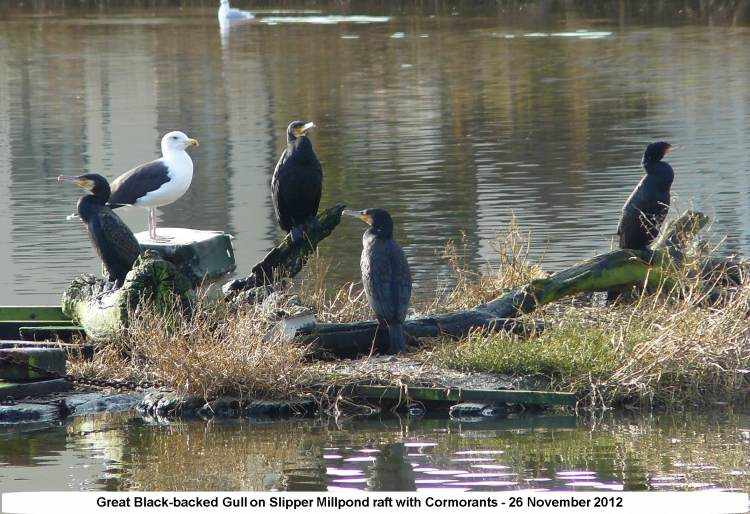
Magpie
taking fat
After 2 weeks of
having absolutely no customers for the fat-filled
coconut shell, yesterday, I decided to break it up and
smear some of the fat into cracks in the bark of our
flowering cherry tree. I recall having done the same a
few years ago and this attracted several species of
bird. I had a totally unexpected first customer to the
new fat display this morning in the form of a Magpie,
which spent several minutes leaping up to the tree
from the ground to snatch pieces of fat from the bark.
Magpies are a fairly scarce visitors to the garden but
I have never seen one behaving in this way.
Intelligent creatures.
Stinking
Iris
I found a Stinking
Iris plant on the edge of Lumley Road with clumps of
bright orange fruits.
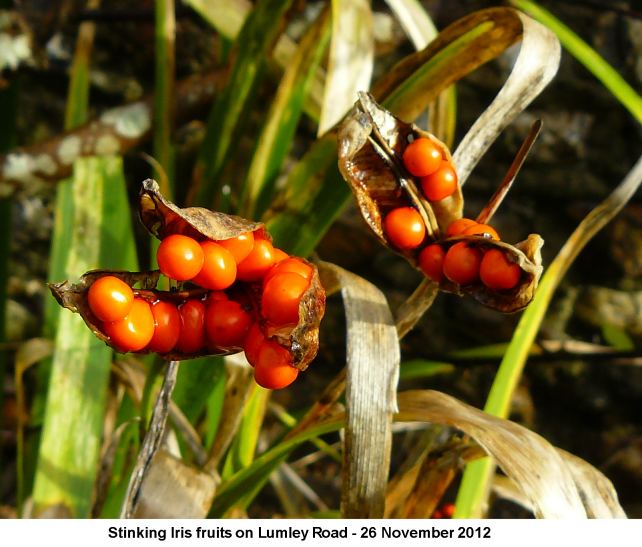
OTHER
NEWS
Spotted
Redshank W+GY
Barry Collins reported
another sighting of the colour-ringed Spotted Redshank
W+GY on the Thorney Great Deeps west side on the 18th
Nov at 1430.
Avian
pox latest
This nasty disease
affecting Great Tits and Dunnock appears to be on the
increase. This disease causes large tumour-like
growths and can result in death. Scientists at the
Institute of Zoology, Edward Grey Institute, BTO and
RSPB have charted the spread of this disease from
southeast England in 2006 into other parts of the
country. See the BTO news bulletin . .
http://bto-enews.org/NXK-12BH6-3UEDCR-F0SH9-0/c.aspx
You can download an avian pox factsheet from
http://bto-enews.org/NXK-12BH6-3UEDCR-EYFII-0/c.aspx
Godwit
news from Pulborough Brooks
Peter Hughes reported
that Black-tailed Godwit numbers had been high in the
Arun valley over the last few days. He found about 185
this morning on the north brooks, though up to 300 had
been reported last week. I assume this increase
follows flooding in the valley.
Today, Pete saw the
following colour-ringed birds:
L//R+LO - My
last personal sighting of L+LO was on 16-Mar-11 at
'Texaco Bay' North Hayling. Nothing last winter.
O//R+LL -
Ringed as first summer male on 26-Jun-05 on Thorney
Island. There have been numerous sightings over the
years in Hayling Island, Emsworth, Pagham Harbour,
Pulborough Brooks, Fishbourne and Bosham. The last
record I have is actually from Pete at Pulborough
Brooks on 10-Nov-09. Nothing over the past two
winters.
Y//R+GR - My
last record of Y+GR was on 01-Jan-12 at Pulborough
Brooks by Ruth Croger. My only personal sighting was
on 09-Feb-10 at Fishbourne.
and
from the Avon Valley
Kevin Sayer reports on
extreme flooding along the Avon Valley. The current
levels are as high as he can remember - certainly as
high as 2002. The Black-tailed Godwits appear to be
moving up and down the valley looking for a suitable
feeding site. With water levels varying so much it is
no surprise they cannot settle. They have been seen
over the last few weeks between the coast at
Christchurch right up to Hucklesbrook. Today Kevin
found a flock of at least 1,000 at Bisterne - there
may be more in other quiet spots.
SUNDAY
NOVEMBER 25 - 2012
NORE
BARN
11:30 - About 2 1/2
hours after high water. The stream was emptying of
tidal water and the Spotted Redshank was already in
place feeding along with a Black-tailed Godwit and a
Black-headed Gull. From the slightly mottled plumage I
would guess the godwit was a juvenile. With rain
threatening I did not stay to see the tide recede any
further.
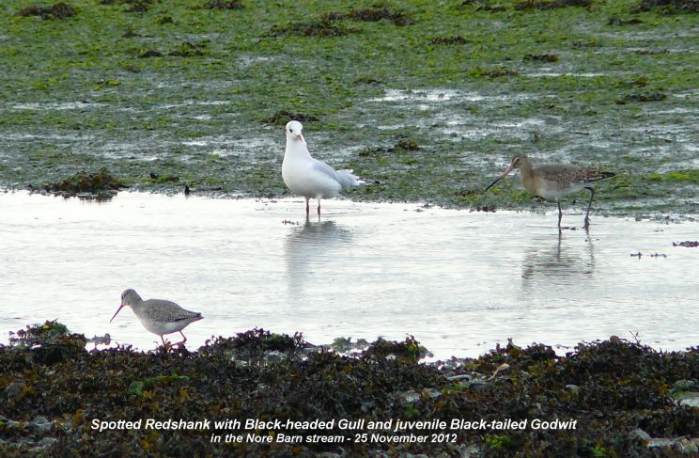
Please
note two new pages .
. . Emsworth's
Millponds
. . . Great
Black-backed Gull nesting
FRIDAY
NOVEMBER 23 - 2012
Emsworth
Harbour
13:00 - Viewing from
the millpond seawall. Tide right out. I kept an eye on
the low water channels for the Spoonbill that was seen
flying towards Emsworth Harbour earlier this week, but
there was no sign of it. A Greenshank
(unringed) was feeding in the town channel with Common
Redshank and Grey Plover. About 40 Coot were in the
main channel, the first of the winter gathering. About
50 Lapwing were on the mudflats.
A flock of 104
Black-tailed Godwits were asleep on the edge of
the main channel. They included three colour-ringed
birds of which I could only see one leg.
WR was most likely
G+WR (an Emsworth regular).
OL could have been
ROL+RLR (another Emsworth regular). The upper red
rings are often hidden in the bird's plumage.
GY was probably G+GY
which I first saw on Nov 19.
Great
Black-backed Gulls
An adult Great
Black-backed Gull was on the pond along with a
juvenile, probably birds from the family that nested
here in the spring/summer. These birds look as if they
have settled here for the winter. I wonder if they
will try to nest again next year?
Flowers
Red Valerian was out
on the millpond seawall. Wild Carrot in flower on the
Wickor Bank on the west side of Thorney Island. These
take my personal November flowering plant list to 69
species. See full list at . . . Winter
flowering plants
Spotted
Redshank W+GY
This is not to report
a sighting, but to say that I have opened a special
page on this bird which was ringed on Thorney Island
in 2008 and which is often seen on Thorney Deeps or in
the stream in Nutbourne Bay. This is where I last saw
it on Nov 13.
See . . . Spotted
Redshank colour-ringed W+GY
Short-eared
Owl
Tony Wootton was in
luck again with a Short-eared Owl about 4pm down at
the end of Thornham Lane on the east side of Thorney
Island. However, there were no ravens
today.
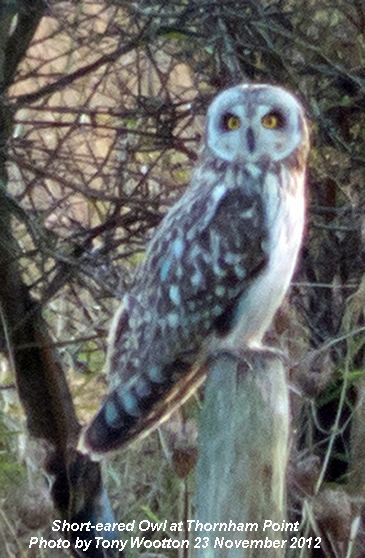
Little
Deeps
Malcolm Phillips got
some good images when he went down the west side of
Thorney Island this afternoon. He saw both male and
female Bearded Tits in the reeds on Thorney
Little Deeps. Here is a female.
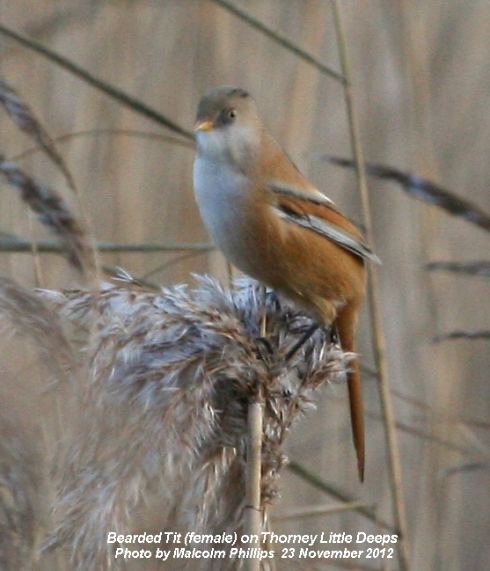
Malcolm also found
some Reed Buntings in the reeds. The sexes of
Reed Buntings are not easy to discern at this time of
the year, but this one could be female or possibly a
first winter male or female.

More
on Sparrowhawk kills
Tom Bickerton replied
to the observations of Ralph Hollins on Sparrowhawk
kills in yesterday's blog as follows:
"This is good stuff, I
think Ralph's correct and Sparrowhawks do eat the
head. If only we could find what's left, whether they
puncture the head or crunch it like a cough
sweet.
Re: Peregrines, which
is probably the bird I've studied the most, their
hunting behaviour patterns change depending on what
situation they find themselves in. With young,
juveniles and bonded pairs, etc. if we take the period
when generally they are alone (August - mid-December),
they usually strike large prey i.e. curlew,
black-tails and the bigger duck. Both male and female
however will catch medium prey. If they take similar
sized birds, pigeons, and Grey and Golden Plovers,
they grasp from below, i.e. the breast area, and then
bite the neck.
I have held medium
prey items, pigeon, gull and dunlin, and the heads are
pulled off, with the spine still there, and it's like
a lolly stick, with a head. Now what I don't have is
evidence of the bigger prey birds with longer necks
such as Curlew, Barwits, Avocets and no duck. This is
partly due to the fact that they have taken the prey
to an inaccessible area. I've found some remains, and
looked for the head, but can't find it. My theory is
that it comes off just below the bill and the neck
length is picked clean. Whether the head, because
bigger, is then devoured as a delicacy, I can't tell.
Now, if hunting gets difficult, do they then eat the
lot, but difficult to tell locally because there are
so many potential prey items for them. Juvenile
feeding behaviour for the first part of their
independence is different from the adults."
THURSDAY
NOVEMBER 22 - 2012
Nore
Barn
15:00 - I made a very
brief visit to Nore Barn this afternoon. The
conditions were awful with a gale force wind blowing
into my face. However, I managed to make out the
Spotted Redshank in the lower stream which was
chasing a Spotted Redshank while I was watching. No
sign of anything else of interest.
I got away from the
wind by walking along the sheltered path north of the
woods. A flock of around 400 corvids were feeding on
the large field of stubble north of the path, mostly
Carrion Crows and Jackdaws. Also, about 100
Starlings were perched on the overhead
telephone wires.
Stonechat
on Thorney
Malcolm Phillips had
his first walk at Thorney Island for a long time and
certainly picked the wrong day with very strong winds
blowing in from the west. However, he managed to get
this nice shot of a female Stonechat on a sheltered
perch in her autumn plumage of warm rufous underparts,
plain head and pale throat. The male was probably not
too far away.
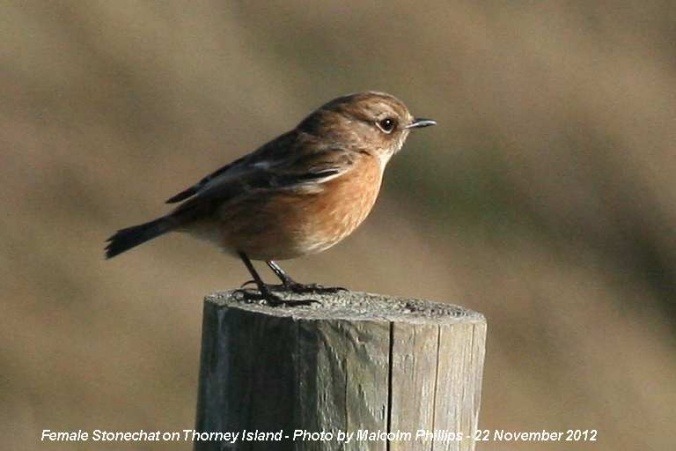
Sparrowhawk
kills
Ralph Hollins
commented on yesterday's discussion of what a
Sparrowhawk eats of the prey it kills.
"I cannot remember
where I read about this but I have for a long time
been aware that Sparrowhawks do seem to regard the
heads of their prey as being something to eat first
before going on to other parts of the body and my
memory is that I had read that this was because the
brain of the prey had the most protein in it.
If that is true you
would think that all raptors would do the same and I
was not aware that Peregrines did not eat the heads
first (if at all) but that might have something to do
with the Peregrines method of killing. A Sparrowhawk
normally kills by strangling its prey (squeezing the
victim's throat in its claw) whereas a Peregrine kills
by striking its victim with a high speed blow to the
neck which may often sever the neck leaving the
Peregrine with only the body of its prey (the head
having fallen away and so not easily found). I cannot
produce any evidence for these theories but would love
to hear more on the subject (especially if backed with
evidence!)"
WEDNESDAY
NOVEMBER 21 - 2012
SPOONBILL
IN EMSWORTH?
On 19 Nov 2012 Jeff
Goodridge reported a Spoonbill over Thorney Island on
SOS Sightings. "While hoping to view a Short-eared Owl
by the Landing Lights at the end of Thornham Lane late
this afternoon, a Spoonbill (too distant to age
without scope) flew east high over the main road then
eventually flew back west towards Emsworth Harbour
then lost to view." Please keep a look out and let me
know if you see anything.
The last Spoonbill we
had in Emsworth was exactly 10 years ago. I was first
alerted to its presence in Emsworth Nov 16 2002 by
Barry Collins, but I did not see the bird until about
2 weeks later on Nov 29. It remained in the Emsworth
Harbour area for at least another two weeks and my
last sighting was on Dec 16. All that time the bird
was relatively easy to see regularly feeding in the
low water channels and it even came onto Emsworth
Millpond on one memorable occasion on Dec 12. Here are
a few snaps from that time.
The
Spoonbill out in the main harbour
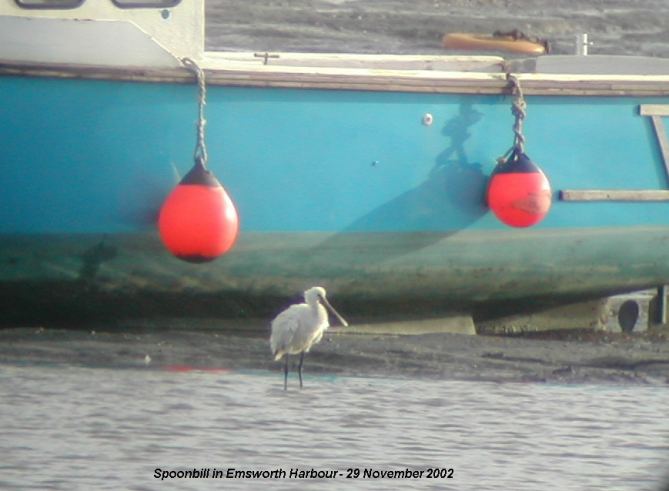
Spoonbill
showing off its strangely shaped bill
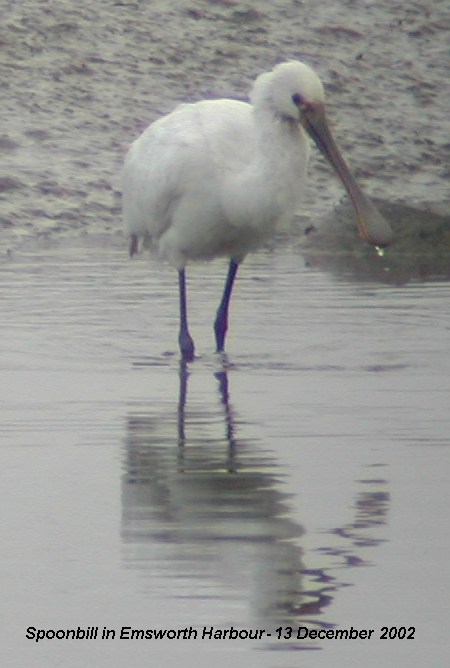
Spoonbill
'spurting'
Here is an interesting
one that I discovered when going through my old
photos. It shows the Spoonbill apparently spurting
water from its bill. This so-called 'spurting'
behaviour has been seen numerous times in recent years
in Black-tailed Godwits, Greenshank, Spotted Redshank,
and other wading birds. It remains a mystery baffling
even the ornithological boffins. See the following
page for more information about this unusual behaviour
. . . Spurting
behaviour
Spoonbill
'spurting' while feeding in Emsworth Harbour in
December 2002

SANDERLING
RESEARCH
Tony Wootton sent
photos of the Sanderlings he took at East Head on Nov
19 to Pete Potts who confirmed they were all ringed in
October 2011 at Eastoke, Hayling Bay. Here is just one
of the photos that Tony sent.
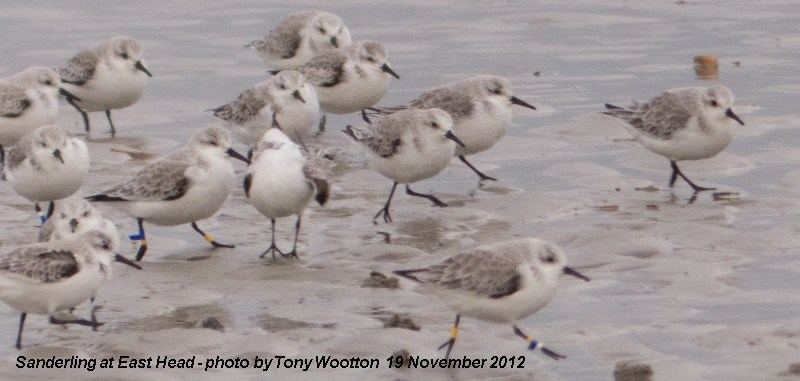
Pete sent them on to
Anne de Potier who maintains the Farlington ringing
group database. Anne had seen some of Tony's birds at
Pilsey on Thorney Island on 14 November. She said they
do move a lot around the harbour, but most of the
colour-ringed sightings they get are from Hayling
because ace-birder Andy Johnson, lives there and is
out almost every day! Here is the link for more
details about the Sanderling research project . . .
http://www.waderstudygroup.org/res/project/sanderling.php
Anne would very much
appreciate receiving more colour-ringed Sanderling
sightings preferably with photos, and date, time,
flock size, to add to the growing knowledge of this
delightful wader. Please send them to me in the first
place and I will pass them on.
SPARROWHAWK
KILL
Having read the report
(Nov 19) by David Minns about the Sparrowhawk kill in
his garden, Tom Bickerton wrote to ask if the hawk
left the head on the Feral Pigeon. Tom has a special
interest in predators and says he has yet to find a
Sparrowhawk kill with a head; they eat the lot. In
contrast, Peregrines usually don't eat the head, they
detach the head at the base of the spine.
The only Sparrowhawk
kill I saw in my garden was on 1 August 2005. A
juvenile male Sparrowhawk swooped in, took a House
Sparrow from the bird table and went down onto the
ground with the Sparrow trapped under its talons. I
watched the whole process for about 40 minutes. First,
the Sparrowhawk plucked all the feathers off its
victim and then proceeded to tear off pieces of flesh
and consume them. Finally, it used some of the
feathers as a 'napkin', to clean off its beak. As
predicted by Tom, nothing was left on the ground but
for the House Sparrow's beak and a pile of feathers.
All very smart and efficient.
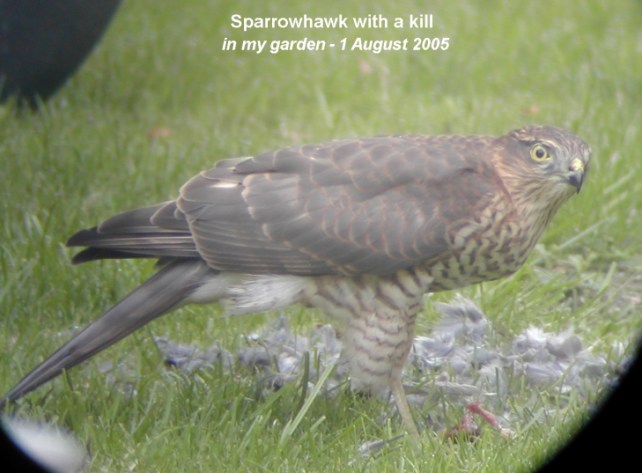
Tom thinks garden kill
gives a perfect opportunity, if undisturbed, to
understand just what the Sparrowhawk eats and what it
leaves. If you have had a kill in your garden then
please let me know the details with a photo if
possible. Tom can then give us his expert opinion.
JAY
IN GARDEN
Malcolm Phillips had
this fine fellow in the garden of his Emsworth flat
yesterday. This is clearly another indication of how
common Jays are this winter in and around gardens. Has
anyone else had one recently?
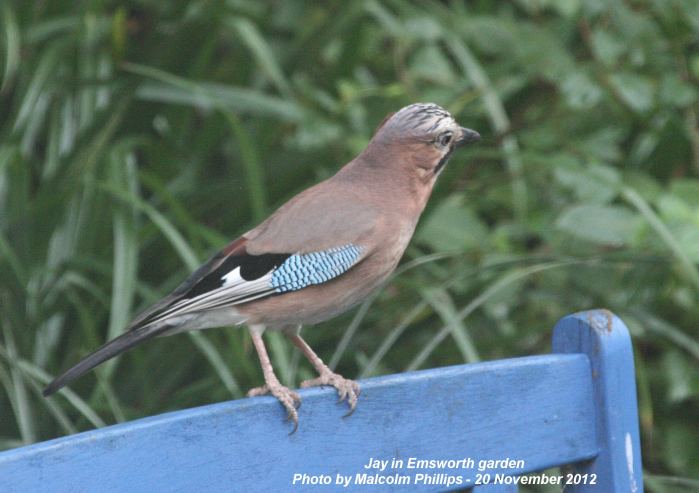
TUESDAY
NOVEMBER 20 - 2012
FINDHORN
NEWS
No special local news
today, but Richard Somerscocks has sent a news up date
of more sightings of Waxwings from his home town in
northern Scotland. He saw another flock of 10 this
morning in Forres which is a town neighbouring
Findhorn. Here is Richard's photo of one of them to
whet our appetites for their arrival down south.

Richard found a flock
of 32 Fieldfares feeding in the same Rowan
trees, with rapidly disappearing berries. Large flocks
have been seen around the north of Scotland in the
last few weeks: 350 in Lerwick, 250 in Ullapool, 420
in Aberdeen, and the largest flock at the Kyle of
Lochalsh on the west coast which numbered some 1200.
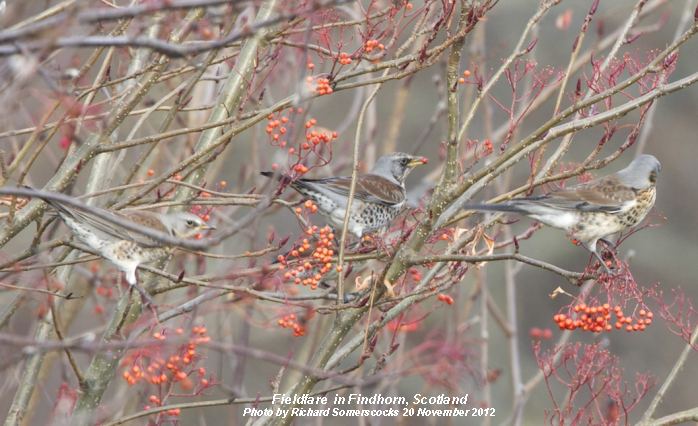
I have created a
special web page for news and photos from Findhorn at
. . . Findhorn
News
MONDAY
NOVEMBER 19 - 2012
EMSWORTH
HARBOUR
11:00 - 12:00 - I was
viewing the harbour from the marina seawall with tide
largely out, but rising. High water at 15:00. Cloudy
and dull with a brisk westerly wind blowing into my
face.
Black-tailed
Godwits
I counted 127
Black-tailed Godwits - feeding mostly along the edge
of the main channel. They included four colour-ringed
birds:
ROL+RLR - Regular in
Emsworth. 6th sighting this season.
WO+LW flag - Regular
in Emsworth. 7th sighting this season
O+WL - 5th sighting in
Emsworth this season
G+GY - Ringed
Farlington 14-Sep-05. Occasional in Emsworth over the
years with 11 previous sightings. This was our first
sighting here this season.
Brent
Geese
Brent Geese 216 - all
aged, but no juveniles. So far this season I have aged
1478 Brent Geese finding just 21 juveniles for a
proportion of 1.42%. A very poor season.
Other
birds
Lapwing 7 - in their
usual spot on the seaweed bank near the main channel.
Coot 30 - wintering flock starting to build up.
Greenshank 4, Dunlin c200, Redshank c50, Turnstone 5.
Plants
I found Black Mustard
still in flower on the marina seawall.
OTHER
NEWS
Garden
birds
I had a fleeting visit
from 4 Long-tailed Tits to my garden this
morning. It was just as well I was looking out of the
window at the time or I would certainly have missed
them. Here are three of them looking for insects on
the pruned roses.
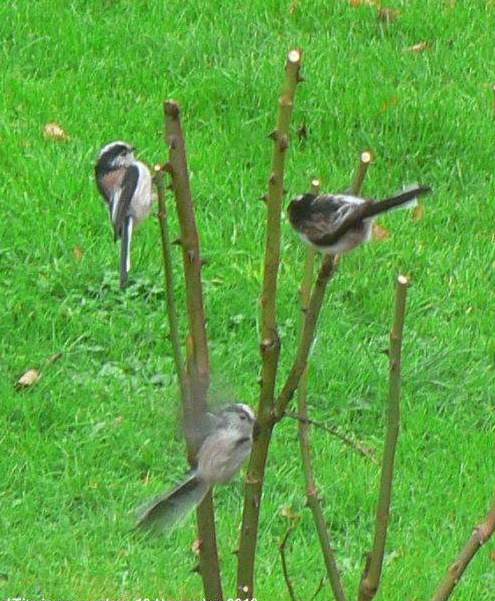
David Minns woke this
morning to find a female Sparrowhawk plucking a
Feral Pigeon in his back garden in the centre of
Emsworth. An amazing bird seen close-up. Having
removed a lot of feathers and eaten some meat, it flew
off with the remains of the carcass.
David also had a
Blackcap singing in his garden in the sunshine
the other day - the first singing Blackcap of the
winter.
Millpond
gull returns
An adult Great
Black-backed Gull was on the centre raft of Slipper
Millpond - possibly one of the pair that nested here
this spring.
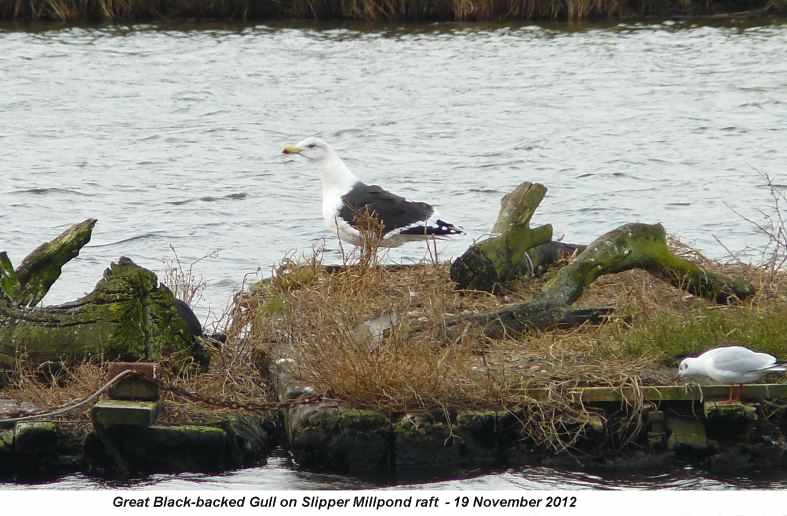
Sanderling
at East Head
Tony Wootton saw about
100 Sanderlings down at East Head an hour before high
tide this afternoon. One of Tony's photos shows
several colour-ringed birds, which were probably from
the catch organised by Pete Potts at Black Point
Hayling Island on 22 Sept 2011.

Brook
Meadow birds
Malcolm Phillips went
round the meadow today from 11.30 till 13,30 and saw a
good selection of birds, including Great Tit, Blue
Tit, Blackcap, Chaffinch, Robin, Treecreeper and
Goldcrest. What a striking crown has this Goldcrest.

SUNDAY
NOVEMBER 18 - 2012
NORE
BARN
11:00 - 12:00 - I went
along to Nore Barn in time to see the stream on a
rising tide. High water at 14:00.
Spotted
Redshank
The first bird in the
stream was the now regular Lapwing. A flock of 20
Black-tailed Godwits were feeding on the mudflats
lower down in the stream channel, but none was
colour-ringed. What I assume was the 'resident'
Spotted Redshank was resting with the godwits and did
not venture into the main stream, probably due to a
high level of people activity with boats. It flew off
to the saltmarshes with the godwits at 12 noon. There
was no sign of Greenshank or the second Spotted
Redshank.
Scandinavian
Blackbird ?
I met Roy Ewing at
Nore Barn who said a lady told him she had seen a
'Scandinavian Blackbird' with a black bill. I said I
had never heard of such a bird, though I knew many of
our wintering Blackbirds do come from that area of the
Continent and at this time of the year they would have
dark bills. The male Blackbird's bill is bright yellow
only in summer and darkens in the winter; the
female/juvenile's bill is dark throughout the year. I
see there is a heated discussion on the web over the
status of the black-billed Scandinavian Blackbird, but
there is nothing about it in the Birds of the Western
Palearctic, which is good enough for me.
Other
observations
A Buzzard was
overhead Nore Barn being mobbed by 8 Carrion Crows.
A Red Admiral
was flying along the path to the south of Nore
Barn Woods.
WESTERN
PARADE
Starling
singing
While cycling along
Western Parade towards Nore Barn I heard the
unmistakable chuckling and whistling song of a
Starling which was perched high on a chimney pot of
one of the houses. I could not resist taking this
digiscoped photo of the bird with its plumage
glistening in the morning sunshine.

Honey
Bees on Ivy
I stopped in front of
the large Ivy hedge near the end of Western Parade
where I could hear the distinct buzzing of bees
feeding on the flowers. There must have been at least
20 Honey Bees, all covered in yellow pollen and
carrying huge pollen baskets on their back legs.

I did not realise the
workers carried on collecting pollen so late in the
year, but clearly they do. There is a web site with
information about the activity of Honey Bees
throughout the year at . . . http://www.countryrubes.com/images/ee_Colony_Activities_Throughout_The_Year_updated_09_09.pdf
I addition to the
Honey Bees there were several Drone Flies
(Eristalis tenax) distinguished by their very
short antennae and lack of pollen baskets. They also
have only one pair of wings.

MYSTERY
RIVER WEED - solved
I was a little anxious
about a luxuriant growth of a green filamentous weed
in several parts of the River Ems on Brook Meadow -
see blog entry for Nov 15. No one seemed to know what
it was, so I sent photos of the plants to our botanist
friend, Martin Rand who reassured me there was no need
to panic! They are non other than the submerged leaves
of a Water Crowfoot. Martin thought that given their
long and drawn-out habit they were probably Ranunculus
penicillatus subsp. pseudofluitans, ie Stream
Water-crowfoot. We have had this on out Brook Meadow
plant list for many years. You live and learn.
FRIDAY
NOVEMBER 16 - 2012
Flowering
plants
I went looking for
wild flowers around some of the local waysides, hoping
to brighten up a very grey November morning. I was
pleasantly surprised by how many I found. There were
several flowers on the straggly Balm plant on the path
from the end of Washington Road just past the railway
bridge.
There was a nice show
of white flowers on the Narrow-leaved Michaelmas
Daisy on the wire fence to the north of the
Emsworth Recreation Ground wayside.

My first Winter
Heliotrope flowers of the winter were open on the
Horndean Road side of the New Brighton Road Junction
wayside.

All the following were
flowering on the new Emsworth Railway Station wayside:
Guernsey Fleabane, Oil-seed Rape, Redshank, Prickly
Sow-thistle, Scentless Mayweed, Field Forget-me-not,
Common Field Speedwell, Wild Radish, Pineappleweed,
Knotgrass, False Oat-grass, Common Fleabane, Black
Medick, Common Knapweed, Bristly Ox-tongue, Cat's-ear,
Dandelion, Michaelmas Daisy, Red Bartsia, Scentless
Mayweed, Scented Mayweed, White Clover, Spear-leaved
Orache, Creeping Thistle.

These take my
flowering plant list for November to 69 species. For
the full list see . . . Flowering
plant lists
Caroline's
news
Caroline French had a
female Blackcap in her garden a day or two
after you reported having one in yours (Nov 10).
Late yesterday
afternoon, I spent about an hour with a friend on
Butser Hill where we saw 120+ Fieldfares and 70+
Redwings moving between Hawthorn trees and a large
open field with stubble in it. The Hawthorn did have
some berries, but not a great deal.
Caroline asked me to
draw your attention to the Brent Lodge Open Weekend
on Saturday 17th and Sunday 18th November. As well
as giving people the chance to see the great work the
hospital does, these open weekends are an important
opportunity to raise much-needed funds. Address: Brent
Lodge Wildlife Hospital, Cow Lane, Sidlesham,
Chichester, PO20 7LN.
Tony's
news
Tony Wootton went down
the east side of Thorney yesterday between 3 and 4.30.
He saw two Short-eared Owls between the end of
Thornham Lane and the army gates.

He was also sure he
saw a pair of Ravens flying overhead, kronking
away. They flew exactly along the line of the sea wall
and carried on in a straight line
northwards.
Findhorn
News
Special
page for Richard's news from Findhorn Bay go to . . .
Findhorn
News
Richard Somerscocks
managed to spot some Waxwings today and as
promised he sent some pictures - just to make us feel
really envious! Richard had a very large flock in the
country about 10 miles south of Findhorn. When he got
home he counted 122 on his photos. Here are a good few
of them in this shot. They are getting a lot of
reports at the moment so it looks like a good year.
But will they get down here - 600 miles to go!

Back at Findhorn Bay
the numbers of Geese are an impressive sight. They
roost on the bay overnight and depart at first light
to feed on the nearby fields before returning just
before dusk. Richard witnessed the spectacle yesterday
when a huge flock of around 4000 Pink-footed
Geese returned to the bay mid-afternoon. Richard
says it is difficult to capture the spectacle from
photos and you certainly cannot get an impression of
the noise they make, but he sent the following image
of a small proportion of the flock about to land on
the bay.

Offshore they are
getting quite a few sightings of Divers and there is a
juvenile Red-throated Diver which is currently
coming in very close and giving excellent views. This
picture was taken this morning.

Most of the Divers,
particularly the Black-throated Divers, stay further
offshore. There were also a number of Slavonian Grebes
feeding with the Velvet Scoters.

For
earlier observations go to . . . .
November
1-15